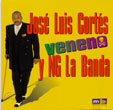Indice - Table of contents
New Stuff[hide]
Musicos: Rafael Paseiro Monzón
Musicos: Dennis Nicles Cobas
Musicos: Jiovanni Cofiño Sánchez
Musicos: Yasser Morejón Pino
Fotos: Tom Ehrlich : 2024 Monterey Jazz, P...
Resenas: Vacilón Santiaguero (Circle 9 ...
Staff: Bill Tilford
Fotos: Tom Ehrlich : 2024 Monterey Jazz, P...
Fotos: Tom Ehrlich : 2024 Monterey Jazz Fe...
Fotos: Tom Ehrlich : testing 123
Grupos: Pupy y los que S... : Discography - 1995- F...
Reportes: From The St... : Cubadisco 2...
Reportes: From The St... : Jazz Plaza ...
Fotos: Tom Ehrlich : Irakere 50th Annivers...
Photos of the Day [hide]
SpanishEnglishDiscography - 1998-Veneno
 1998 - Veneno - This is the first NG album after the departure of drummer Calixto Oviedo for Denmark. He was replaced by the great Jimmy Branly, who himself left for Los ángeles before Veneno was recorded. His student, Jorge Baglan, played drums on this disc and is still with the group today. Mena had also taken off for Italy and was replaced by Joaquín "El Kid" Díaz, who sings one of Veneno’s best tracks, "La Dura". Tosco also added a fourth singer, Yeni Valdés. Her interpretation of "Veneno" displeased some NG fans, but others loved it, including Juan Formell, who later hired her to sing with Los Van Van and also borrowed Tosco’s arranging idea of incorporating the theme from Weather Report’s "Birdland" into a salsa arrangement. Another interesting aspect of the title track is the similarity of its coro to Bamboleo’s "Con un Canto en el Pecho" from the same year, and the vague similarity of both to Paul Simon’s "Our Little Town".
1998 - Veneno - This is the first NG album after the departure of drummer Calixto Oviedo for Denmark. He was replaced by the great Jimmy Branly, who himself left for Los ángeles before Veneno was recorded. His student, Jorge Baglan, played drums on this disc and is still with the group today. Mena had also taken off for Italy and was replaced by Joaquín "El Kid" Díaz, who sings one of Veneno’s best tracks, "La Dura". Tosco also added a fourth singer, Yeni Valdés. Her interpretation of "Veneno" displeased some NG fans, but others loved it, including Juan Formell, who later hired her to sing with Los Van Van and also borrowed Tosco’s arranging idea of incorporating the theme from Weather Report’s "Birdland" into a salsa arrangement. Another interesting aspect of the title track is the similarity of its coro to Bamboleo’s "Con un Canto en el Pecho" from the same year, and the vague similarity of both to Paul Simon’s "Our Little Town".
Three of the tracks on "Veneno" are pure, hard-driving NG Timba. "La Dura" has a very strong Manolin-esque, gospel-timba flavor and also recalls the earlier NG classic "Hice mi Papel" from "La Que Manda". The coro at 1:21 is to die for. The opening track, "Como Me la Gana" has a simple but effective arrangement along the lines of "Los Sitios Entero". It has one great montuno, two great coros, a couple mambos and a lot of great, vintage Tony Calá. "Verano Habanera" also features Calá, and again, the coros are irresistibly catchy. If you’ve spent much time in Havana, you can close your eyes and take a tour of the city as you listen to Tony’s travelogue guías. The other eight songs are in a variety of pop styles. Calá, who had been having some health problems, is not always in top form, but still sounds good, and as great as ever in many places. The horns were unfortunately not recorded carefully and the intonation is frequently not up to the standard set by earlier incarnations of "Los Metales de Terror" but Tosco’s hook-writing abilities are still raging. Whether he’s writing Timba, R&B, or world pop, the songs are full of strong melodies and harmonies and almost uniformly brilliant coros. One of the most addictive coros is on "Cucalambé", which starts in a world pop groove and then takes a hard left turn into a Tosco rap on Westinghouse and Chevrolet’s before taking another hard right into a Timba groove based on Charanga Habanera’s "Tremenda Atmósfera". Another world pop tune with a dynamite coro is "Pregón de Mandarina". It’s tempting to say that "Conga de los Refranes" is influenced by Juan Luis Guerra’s "Mi PC", but again, they came out in the same year.





















